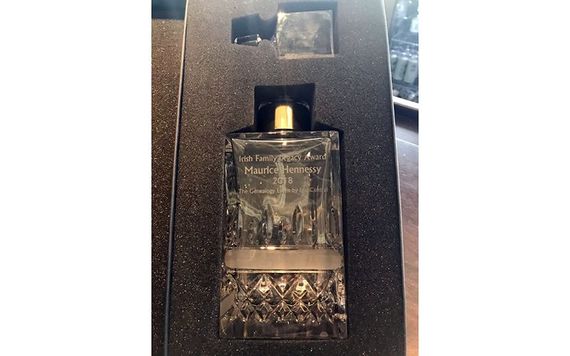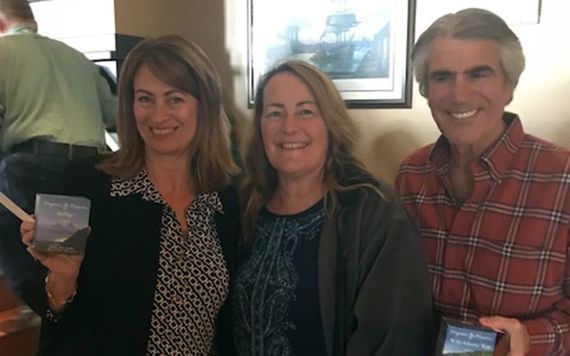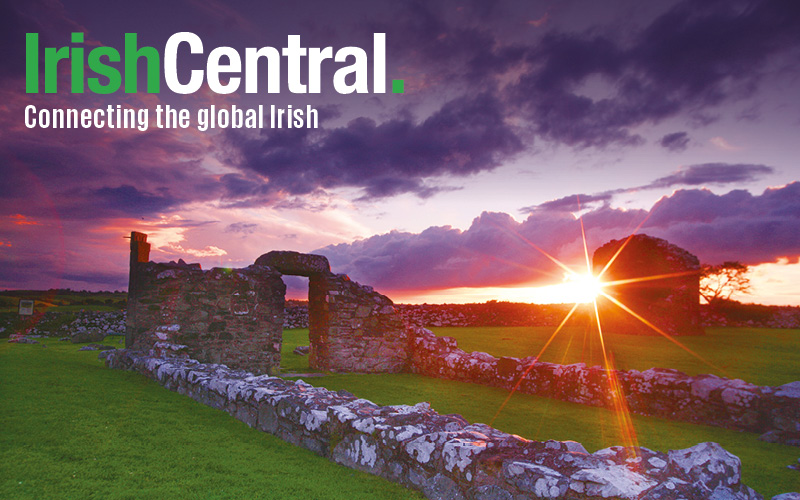On Saturday, October 13, in Pier A, Battery Place, The Genealogy Event NYC gathered genealogy and Irish heritage enthusiasts together for a packed one-day overview of the tips and tricks needed to delve deeper into your Irish family history.
Sponsored by Hennessy, IrishCentral, along with Ireland of the Welcomes and Eternally Irish, hosted The Genealogy Event, New York, on Saturday, October 13, in the beautiful and historic Pier A, Battery Park.
Almost ready to start here @GenealogyEvent at @PierA_NYC #tgeNYC pic.twitter.com/lme6L60LXw
— Eternally Irish (@irisheternally) October 13, 2018
With talks from the New York Public Library and the Archdiocese of New York, the special guest for the evening was Maurice Hennessy, the eighth-generation member of the Hennessy family, who traveled to the US to receive the Irish Legacy Award recognized with an engraved Waterford Crystal decanter.

Maurice Hennessy, the eighth-generation member of the Hennessy family, received the Irish Legacy Award, an engraved Waterford Crystal decanter.
He concluded the day with a presentation on the history and heritage of Hennessy before a cocktail hour.
The morning was started by The Genealogy Event founder Bridget Bray, who provided an introduction to genealogy and a guide to the key Irish genealogy resources.
Read more: How do you find out if you’re Irish or how Irish you are during National Family History Month?
Ready to go at @GenealogyEvent NYC! Tickets still available at the door so be sure to pop into us at @pieraha #tgeNYC pic.twitter.com/nQO8WMmYdl
— IrishCentral (@IrishCentral) October 13, 2018
All things DNA was next in the line-up with an overview from Chuck Weinstein.
“DNA is a great tool when you don’t have a paper trail, but there you’re going to have to open yourself up because people may not be looking for you, they may not even be aware of you," Weinstein advised.
“DNA may tell you that you’re 85% Irish, but it won't tell you what county, what town. However, it may give you an idea of where to look.”
Weinstein also had great practical advice for those who have a hard time with the spit variety of DNA tests: take a toothbrush to scrape cells from your cheeks and then spit.
“Most of us are not pure anything, our ancestors moved around. We were mongrels. That’s ok - it’s what makes the world a better place.” #tgeNYC pic.twitter.com/KF4URKtS9z
— IrishCentral (@IrishCentral) October 13, 2018
After lunch, we heard from Philip Sutton from the New York Public Library on their Irish and Irish American resources.
“Librarians love collecting little bibs and bobs of ephemera. We have hundreds of thousands of postcards of buildings, famous residences, lots of local history. If you’re interested in the neighborhood your ancestor lived in at the time, we might have a postcard about that," he explained.
Read more: National Family History Month: Irish Famine refugee's story of arrival in America
“Just about everybody who’s doing genealogical research in this country, what they’re after is the place of origin. If you’re struggling with this, you can email [email protected]. Write to us, come to the library.” @GenealogyEvent @nypl #tgeNYC pic.twitter.com/PqJ3hNxriF
— IrishCentral (@IrishCentral) October 13, 2018
To give us all a fantastic example of just what can be retrieved with their resources, Sutton traced the life of an Irishman who fought with the 69th regiment in the Civil War named Bernard Trainor, using the records of the United States Sanitary Commission. Through this, he was able to learn that he was born in Strabane, had two daughters and a wife who predeceased him in 1863. He could also find that he was shot through the shoulder at Gettysburg and honorably discharged. He even found two addresses where he lived in New York!
“You’ll find answers to your genealogy research not just in ancestry and genealogy databases but also in historical databases.”@GenealogyEvent @nypl #tgeNYC pic.twitter.com/wB690htZ2D
— IrishCentral (@IrishCentral) October 13, 2018
Next up was Kate Feighery from the Archives of the Archdiocese of New York City, who had some pretty incredible stats about Catholics in the US: “Today, almost 16 million Catholics in the US identify as Irish or Irish America. And here in New York, we’ve had only one Bishop who wasn’t able to claim some Irish ancestry. For the bulk of our history, most of our priests were of Irish descent.”
She advised: “Knowing whether a Parish was formed to cater to a specific ethnic group can help you add or eliminate the parish from your search. The Irish presence was so dominant in the Archdiocese of New York that traditional territorial parishes were for the Irish.
“In the Catholic church, the church of baptism is considered to be the person’s church of origin.” @GenealogyEvent @ArchNYArchives #tgeNYC pic.twitter.com/AxInLBwt87
— IrishCentral (@IrishCentral) October 13, 2018
“The registers with the most genealogical value are the baptismal and marriage registers. Pre 1917, there were no regulations for the information that had to be included, so it can vary from parish to parish.
“In the Catholic church, the church of baptism is considered to be the person’s church of origin," Feighery added, as if future sacraments were received in other churches, they were supposed to be sent back to the church of origin and added to the records there.
"An Irish wake is where we share stories, memories, all the concepts and ideas about the person who just passed. But how often, when it’s over, do we find we’ve forgotten so much of it?" @GenealogyEvent @irisheternally #tgeNYC pic.twitter.com/f3swYlDCWm
— IrishCentral (@IrishCentral) October 13, 2018
Chuck Weinstein returned in the afternoon to talk advanced research strategies and to speak further on the resources available to you. Even if, as he noted one attendee as saying, "their family member must have swum here because she can’t find him anywhere in the arrivals documentation… These are techniques you can use to break through these brick wall.”
“Even for the Irish, some of the names that people had, that they came over with or used when they first came over to the United States, are hard to decipher," he said.
An Irish wake is where we share stories, memories, all the concepts and ideas about the person who just passed. But how often, when it’s over, do we find we’ve forgotten so much of it? @GenealogyEvent #tgeNYC pic.twitter.com/i4RJo3cL7v
— IrishCentral (@IrishCentral) October 13, 2018
"How many ways are there to spell Eoin… So when you’re looking at these transcriptions and you don’t see your family member’s name, don’t give up.
“They’re there, they’re just hiding on you. With it being almost Halloween, it’s the perfect time for your Irish ancestors to be playing a little joke on you. But they’re there, keep looking.”
Weinstein also had some extremely useful advice on names once your ancestors arrived in the US: “No names were ever changed at Ellis Island. People changed their names once they arrived here, they were looking for a more American-sounding name, or friends or family who were already here suggested it. And it wasn’t until the 1940s that New York had a legal process for people changing their names.
“Names and dates are not really what genealogy is about, it’s the stories of who these people were.” @GenealogyEvent #tgeNYC pic.twitter.com/LFTpg5B7R1
— IrishCentral (@IrishCentral) October 13, 2018
“The census records you have to take with a grain of salt because not everyone reported correctly. What you can usually count on is head of the household, their spouse, their children, and where they were born. The information is as accurate as the person who gave the information.
“Even in the late 1800s in this country it was common to see no Irish allowed or no Irish need apply signs on buildings and in newspaper ads, so many Irish did not want to admit that they were Irish.”
He also had some good advice on the best things to focus on: “When you’re interviewing, start with the oldest person you know in the family.
“Names and dates are not really what genealogy is about, it’s the stories of who these people were.”

Winners of candles and diffusers donated by Fragrance & Memories at The Genealogy Event.
Guests were also provided opportunities to win special giveaways: candles and diffusers evoking the Irish landscape which were donated by Fragrance & Memories and free Black 47 movie downloads from Vudu.
The day concluded with a reception, sponsored by Hennessy featuring specially crafted cocktails.
Do you have any other bits of advice? Leave them for us in the comments section, below.




Comments